Blog Layout
COVID-19 Information
Mar 23, 2020
For our employees affected by the reduction in on-site support, please watch the video below about the NM Unemployment program to provide financial support during the COVID-19 crises. Additionally, we’ve provided a Fact Sheet provided by the NM Department of Workforce Solutions.
NM Department of Workforce Solutions COVID-19 Fact Sheet

Please use the following links for more information about the Coronavirus (COVID-19)


Our Recent Articles

By Jess Robertson
•
28 Feb, 2024
Limitless Power From Dirt Microbial Fuel Cells are not a new idea. The concept of harvesting and harnessing power from the microbial activity found in dirt has been around for decades. But with the idea has also come a fair share of problems. From high cost and low energy output to reliability and efficiency, MFCs haven’t been a big player in the energy game. But with recent research - and success - a dirt-powered battery may just be plausible in our future. Where Persistence Pays Off At Northwestern University, MFCs might have finally earned their spot in the limelight. Researcher and developer Bill Yen said alumni were motivated to create a decentralized network of devices that didn’t rely on Lithium batteries, heavy metals, or other toxins that pose a threat to the environment. By utilizing the microbial activity in dirt one can efficiently capture and harness a small amount of power that can be used in lower-power operations and applications. This makes MFCs ideal for tasks involved in farming. Where traditional MFCs struggled to work in overly wet areas or too dry climates, there was also the factor of adequate sunlight, debris complications, and power output. In a standard MFC model, the anode and cathode run parallel to each other. Because of this setup, debris can obstruct operations. But instead, the Northwestern team ran their model perpendicularly. This placed the power-generated elements buried in the dirt and kept the cap above ground to continue the oxygenation required for electricity generation, minimizing debris interference. Essentially this vertical design guarantees that everything is in its designated place, no debris can enter the device, and it can continue to function in dryer soils and even in flooding. And what’s more? Northwestern’s new design not only generated enough power, but generated 68 times as much power as needed to run its sensor - those are good odds. Where can we use it? This new MFC could potentially play an exciting role in the agriculture realm. The agricultural industries could greatly benefit from small sensors that could monitor activity (like water output, soil temp, etc.) in order to maximize efficiency. These would increase productivity and output. As of right now, implementing an MFC sensor system has proved difficult. From the sheer amount of devices installed, to the time it takes to change and check batteries, to the unreliable feedback, it’s not a viable investment for farmers. But with Northwestern’s new MFCs, all of these problems could be solved. With its small design, it’s not only feasible to install these throughout acres of crops, but it’s very realistic to see how they could reliably transfer and monitor data during a variety of weather conditions, making crop production more efficient and predictable. The best news? The cost. In the past, MFCs have been counterintuitive due to their high cost. But now? Northwestern built their entire unit out of parts from the hardware store. Cost is now no longer a huge factor in the MFC game. With a new design and a few tweaks to an old method, these new MFCs may just be the next phase in farming. Keep A Look Out So keep a lookout for MFCs and how they’ll play a part in tomorrow’s energy game. With the potential to capture almost limitless energy from dirt, it’s an exciting new avenue with lots of potential and few, if any, risks. That’s something we can all be excited about.
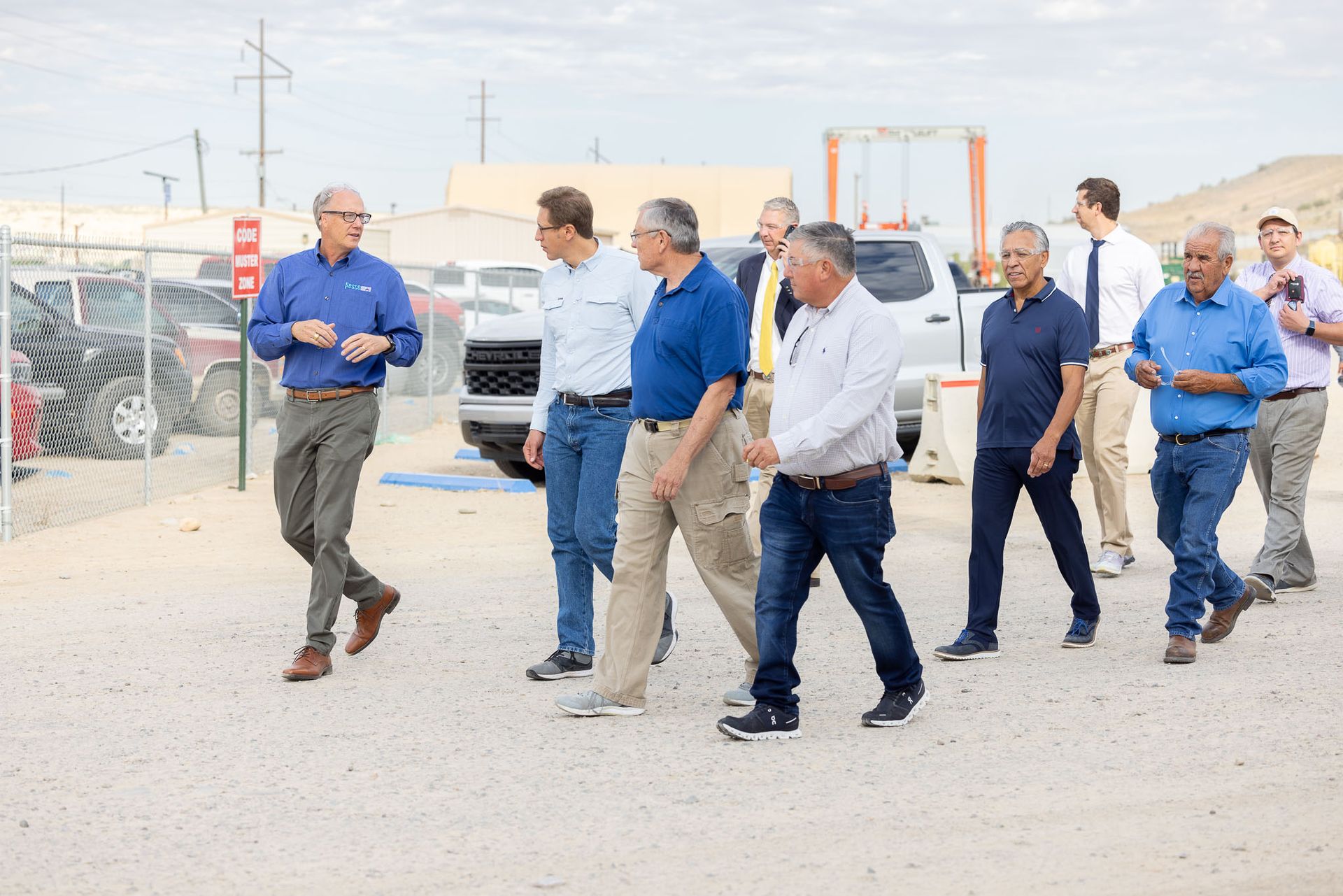
By Jess Robertson
•
16 Feb, 2024
When it comes to logistics, details, and new technologies, John Byrom is your guy. With a calm demeanor that never seems flustered, John has learned to take things in stride, working through problems and looking for opportunities with an eye toward innovation and change to reach the objective. And that’s just what he’s doing at PESCO. His role as Business Development Manager for the last seven years has provided him the chance to gather his previous work experiences and channel them effectively into pushing PESCO to look beyond the status quo and towards bigger potential. Where He’s Been Being a Farmington local, John inevitably sought the chance to return home when the time came. After graduating from Texas A&M, he began working for Union Carbide Corporation in Houston, Texas. Dealing with pipelines and petrochemical products, he gained invaluable leadership experience while learning about facets of the petrochemical industry, as well as how large corporations function with their focus on strategic planning and formal systems and processes for continuous improvement. But with home continuing to draw him back, he took a job in Farmington working for a small oil and gas company, D.J. Simmons, where he worked for 20 years. John was given the opportunity to see the world of business behind the scenes and up close, helping to lead an entire business from long-range planning to the daily challenges of operations, personnel management, and cash flow. While some may question his decision to step off the major company corporate ladder, John certainly did not. He knew what a blessing it was to be back in Farmington and was enthused to put what he had learned into practice and to continue learning. It is that continuous desire to keep learning that is a trademark of John’s character. Not afraid to push past boundaries, he calmly and resiliently continues to look toward the future and find ways to progress. Where He Is Now With the economic downturn of 2015, John made his move over to PESCO. Having known PESCO President and CEO Kyle Rhodes for many years in various areas of the community, he knew it would be a good fit from the start. And it was. So what was John’s new role at PESCO? Stemming back to his knack for systemization and unyielding curiosity for learning, John is responsible for business development, including finding new applications, technologies, and products where PESCO can use its strengths. He’s looking at how to maximize efficiencies in oil and gas, as well as find areas beyond oil and gas where PESCO can branch out into new horizons. He guides in strategic planning, helping PESCO reach long-term goals by looking for more effective methods and implementing the steps to reach those goals. He loves working with the PESCO leadership team to help set up new methods and practices so that PESCO can run the smoothest and most efficiently. Essentially, John is given the privilege to think outside the box. And it’s working. With the encouragement of Kyle and the rest of the leadership team, not only is John pushing boundaries by thinking outside the box, but this mindset has seeped into the company culture - for the better. With an established company like PESCO that’s been in business for over 53 years, it can be easy to gravitate towards keeping things the same. Change can seem scary with the looming fear of failure and branching out into new arenas can feel difficult because oil and gas is what PESCO has done so well for decades. But if you aren’t innovating and growing, you run the risk of stagnation and decay. John is always pushing toward the next, new thing to make PESCO a better company for its owners, customers, and employees. PESCO’s culture continues to shift away from accepting the routine as is. With involvement from leaders like John, teams approach their problems differently, taking time to understand the process, what is broken, and how to not just fix the problem, but improve the system so those problems don’t happen again. Without the fear of failure, new strategies can be tried, learned from, adapted and implemented. Perfection may not always be attainable, but continuous improvement is. John has helped steer the culture toward working through problems creatively and seeing the great potential that can follow. Where He’s Going - The Flywheel In Jim Collins's book, Good to Great, he references an example called the Flywheel analogy - something John emphasizes in his work at PESCO. In essence, momentum occurs with innumerable small pushes in the same direction repeatedly. It’s challenging at first, of course. But with each continuous effort pushing in the same direction, the work progressively gets easier, the momentum builds, and your hard work has paid off. You’re now spinning your flywheel with ease, confidence, and experience. And John feels that PESCO’s flywheel is really starting to roll. Where some companies rely on quick-fix schemes to build momentum, they eventually limit their progress. Changing from one tactic to another, they are constantly changing directions and going nowhere, never gaining any momentum. But that’s not PESCO. All the hard work and dedication that PESCO employees have put in over the last half a century is truly paying off. PESCO is a strong company, surviving economic downturns, staying ahead of competitors, and working diligently to produce the best equipment, all while investing in employees and the community. This sets up PESCO to not only maintain its leadership in oil and gas, but will give it an advantage as it expands into new industries as well. The flywheel is spinning fast now - and John is thrilled to be a part of it. He’s motivated to continue pushing the boundaries, to keep pushing PESCO further, and is proud to be a part of a company that has built such a bright future for itself. The diligent work in the past, and now, is gaining fabulous traction for PESCO - and John can’t wait to see where it leads.

By Jess Robertson
•
16 Jan, 2024
While the oil and gas industry continues to produce and fuel our economy, the pursuit of alternative energy sources continues to spark interest among Oil and Gas (O&G) companies. By looking at readily available resources already in place within the oil and gas structure, new ideas are emerging for how to maximize things like wastewater to bring even more efficiency to the table. Produced water from O&G wells has long posed problems for the oil and gas industry. Because it contains mineral salts, organic compounds, and heavy metals, disposing of it has proven challenging. In the past, a tiny percentage of wastewater has been used in various ways like fire control, power generation, equipment and vehicular washing, or even irrigating non-edible crops where the water is shown to be clear enough. However, most wastewater is either treated and reused for fracking in place of using fresh water, or it is disposed of in wells deep underground. But what if we could get more out of O&G wastewater? Now we can. And the potential has huge benefits not only for the O&G industry but for our nation as a whole. Lithium With the increasing demand for Lithium (Li), it’s hard not to wonder if and when the monopoly will begin in South American, China, and Australian Li recovery operations. Because they are some of the world’s biggest suppliers, places like North America and Europe are growing dependent on their production. Our dependency on lithium is due to its use in the energy-storage sector, not only in Li-ion batteries but also in its potential use in thermonuclear fusion. And let’s not forget smartphones and other electronics, or how it’s used in CO2 adsorbents that are used in submarines and aircraft. Because of its increasing value and consumption, the search for Lithium has spurred researchers to start looking in unexpected places and new innovative ways to recover Lithium in locations we had previously thought impossible. Like the oil and gas industry. Lithium in O&G Wastewater For years lithium has been known to be in water produced with crude oil and natural gas from underground reservoirs. On locations such as the Smackover Brine - a large limestone aquifer spanning Arkansas, Louisiana, Mississippi, and Alabama - Li extraction has proven fruitful and promising. The current method of extraction on locations such as this is evaporative ponds, harnessing roughly 209,000tpa (tonnes per annum) from the El Dorado , Southern Arkansas location alone. But evaporative ponds do have their downfall. The evaporation process is lengthy - taking a full year for the complete process - and Li levels must be highly concentrated in the water in order for this method to work. Thus, the oil and gas industry has been largely overlooked because the Li levels in wastewater from oil and gas are far less concentrated. Does that mean O&G wastewater as a source for Li is a non-starter? Innovators today say no. Here’s why. Absorbents and Membranes The problem with O&G wastewater is its lower levels of Li concentration and Li’s difficulty in being selectively recovered. But with shale plays in the Eagle Ford and Permian Basins in Texas generating millions of gallons of produced water every day, it’s imperative to look towards a ripe opportunity to glean such a valuable element. And emerging technologies may just have found a way to do that. Absorbents Commonly used in water purification and decontamination, ion-exchanged absorbents have long been utilized. But unlike other minerals and heavy metals, Li is much harder to selectively absorb. With O&G wastewater containing such high values of other elements, companies like Dow Chemical in the U.S. are approaching the problem from a new angle. By developing an aluminum-loaded resin, they were able to successfully select Li from brine water. In fact, several companies - FMC, Simbol, and Eramet - have seen the promise in aluminum-based absorbers and have their own patents. Similarly, other companies have infused a specific chemical compound that makes it highly selective for Li, separating it from sodium and potassium ions. These infused solvent resins have proved very promising in the Li recovery game. Membrane Another method currently underway utilizes membrane technology - and it’s already showing potential. What’s great about membrane technologies is their ability to be applied to wastewater that has a far lower concentration of Li, which is typical of most oil and gas wastewater. Furthermore, membrane technology can be utilized on a variety of wastewater and brines, and is less costly than absorbents, making it more versatile and alluring to the oil and gas industry. A recent test was done using this strategy, studying nano-filtration and low-pressure reverse osmosis to separate the Li-ion from wastewater brine. With favorable results, this method of extraction will undoubtedly continue to grow in practicality for Li extraction. In fact, our very own New Mexico Institute of Mining and Technology is actively developing new membrane systems specially designed for Li extraction as well. The Bottom Line The Li demand is only increasing and O&G water may prove a part of the solution. With emerging technologies, existing O&G locations could be utilized to harvest Li while making more use of produced water. Shale plays across the U.S. have Li amounts to boast of, some comparable to known Li deposits. Tapping into this valuable resource not only enables the U.S. to be a bigger player and less dependent on other countries, but enables the O&G industry as a whole to be more resourceful, and more well-rounded in making the most of all the products that come with oil and gas, and help pave the way for more energy tomorrow.
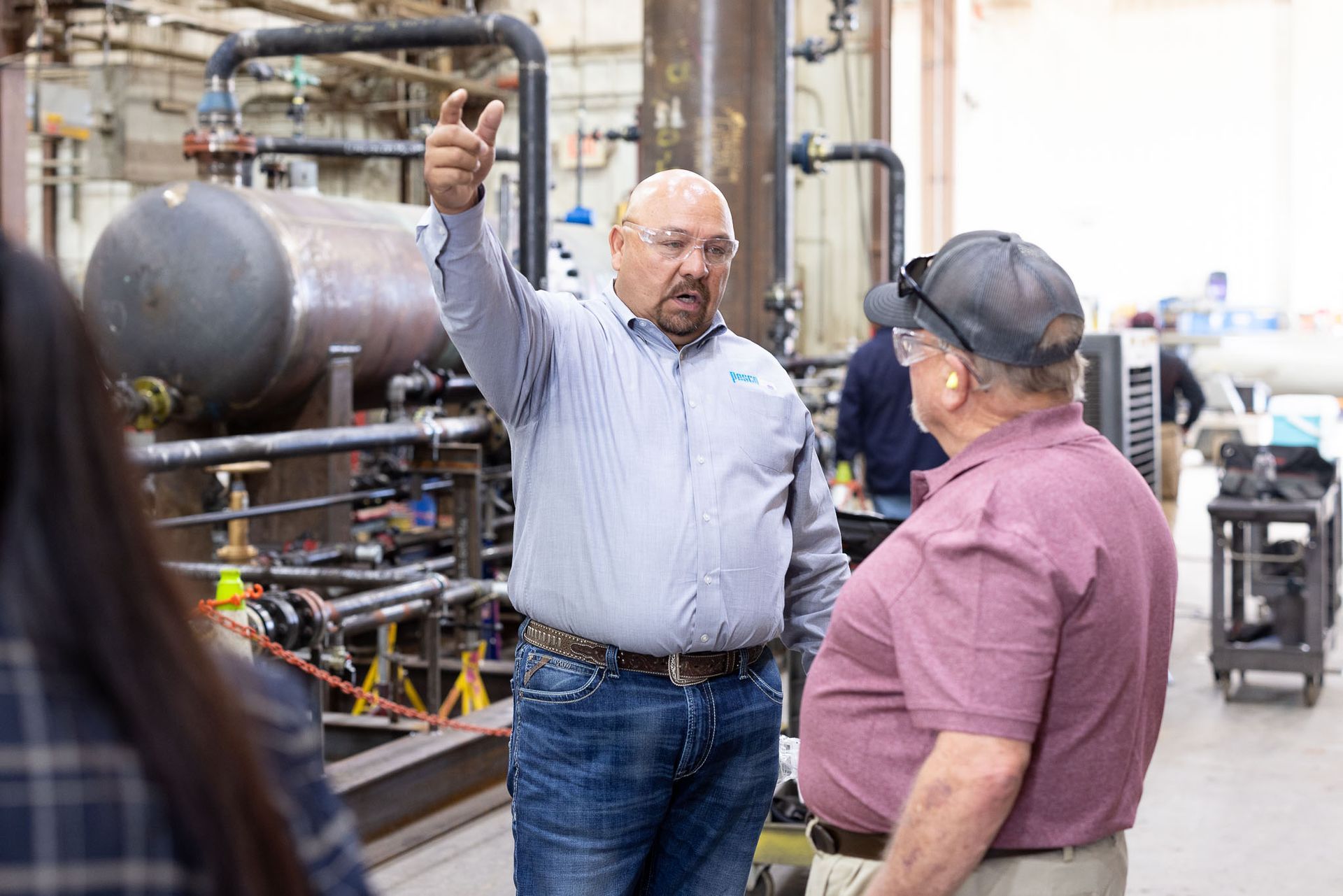
By Jess Robertson
•
01 Dec, 2023
Being a salesman in the oil and gas industry poses its fair share of competition. With a multitude of salesmen out fighting for the same client, it can be hard to stand out. When everyone is essentially selling the same product at varying prices, just how is it that some salesmen and companies seem to continually keep getting bid after bid? Just how do they do it? Is it better pricing? More expansive workspace? Or is it a matter of wining and dining the potential customer? Well for PESCO, it’s more than all of the above. For a grassroots company that has vastly expanded over the years, the basis still remains the same for how the company treats its own employees as well as how they approach sales: Relationships. The Difference When it comes to selling your company to a prospective client, there’s a lot of information to cover in a short amount of time. From your company’s values and products to their reputation and capabilities, you convey all that information in a way that stands out from the rest. So how do you do that effectively? While you could read off facts and statistics from a brochure coupled with your memorized sales pitch about your company - you run the risk of sounding just like everyone else. PESCO approaches sales differently - and it's working. 1. Get to Know the client And that’s not just a figure of speech. When PESCO salesmen meet with prospective clients, it’s not just about closing the deal. It’s about a genuine amount of time spent getting to know the client. What are their interests outside of work? What is their family life like? What do they value in their job and in their employees? What makes them proud of where they work? This effort to get to know customers isn’t just a tactic to be different. PESCO has established a company culture that these partnerships should be ongoing, spanning decades, and that people come before the product. Because when you actually get to know someone, it takes business negotiations and transforms them from transactions to actual conversations. It becomes an ongoing discussion that makes it more natural and easier to see where a need needs to be met. And when PESCO sees that need, they can step in and fill it. 2. Sell PESCO As a Whole It can be easy when selling a business to gravitate towards leaning heavily on one facet of the company. Maybe you hone in on the variety of products offered or the amount manufactured per year. But for PESCO, it’s a company sold as an entire package from the ground up. With a robust team of engineers and drafters, coupled with an expansive shop staffed with talented and hard-working individuals, it’s easy to showcase why PESCO produces superior quality - from the shop to the CEO’s office. Because so much is focused on employee care, PESCO functions with quality and integrity from the ground up. Because when everyone has pride in their work, everyone’s work is exceptional. 3. Capitalize on Customization. As with any industry, figuring out how to stand out from the competition is crucial for success - and PESCO has found their niche. While they are capable of manufacturing multitudes of standard units, customizing is where PESCO truly shines. From patented units designed in-house to taking units and refurbishing them to their full potential to creatively engineering around problems, PESCO has taken customization to a whole new level of efficiency. You see, when it comes to existing or new clients, PESCO isn’t worried about what’s in store. They know how to out-design the obstacles before them, giving them another opportunity to outshine the competition. Different = Better So even with heavy competition in the oil and gas industry, PESCO has learned how to make their mark. With a unique approach that follows their company standards of people first, they’re shaking up the industry with long-lasting partnerships that produce exceptional products for valued customers. They’re doing it differently - and different is definitely working.
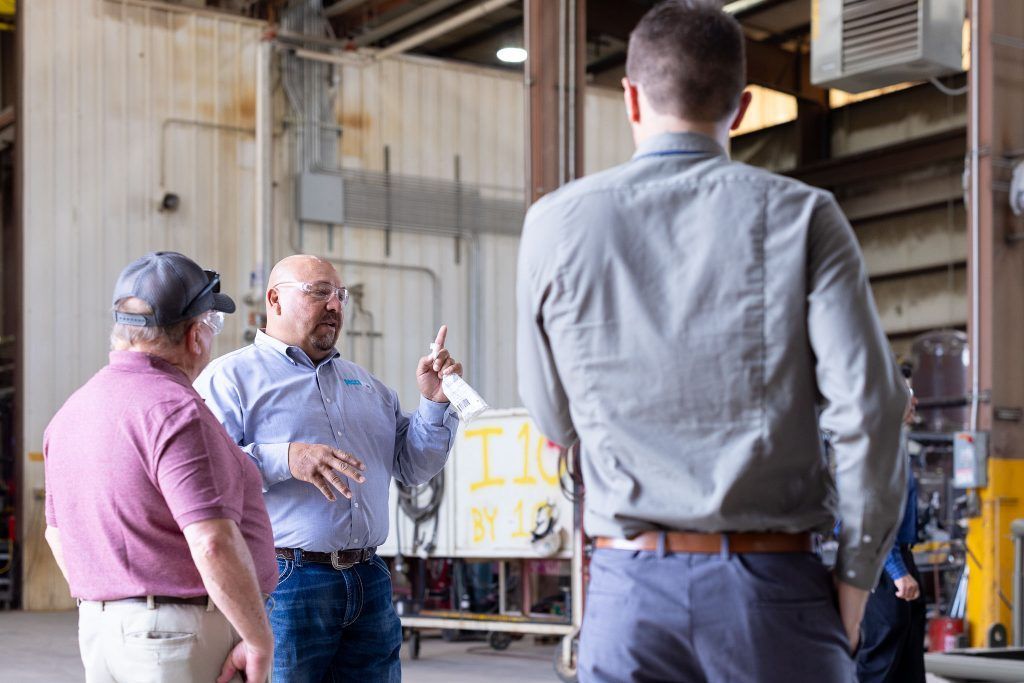
05 Oct, 2023
If you were to meet Tony out of the blue, he would be the guy you can easily strike up a conversation with, chatting for hours, like he’s known you for years. With a congenial and jovial disposition – and the gift of gab – Tony is not only personable, but is an endearing individual who genuinely takes the time to listen to you. That’s one of the many reasons PESCO is thrilled to have him as part of their staff. But Tony’s story goes much deeper than just being a good conversationalist. His story with PESCO is one of loyalty, generosity, and appreciation. Tony’s experience with PESCO sheds a light on PESCO’s company culture that is wholeheartedly about investing in their employees and always putting them first.

15 Aug, 2023
When it comes to separators, any process equipment company in the industry has their version. But as with most things, standard one-size-fits-all products have their downfalls. Sure, the unit will work, but how well will it work? Standard products deliver standard results. But at PESCO we don’t aim for standard – we shoot for exceptional. At PESCO, the units we build don’t just work, they’re flawlessly optimized for your conditions. And our customers can attest. Whether it be perfectly sizing a unit, or designing a customized, tailored product, or something engineered outside of the box, our commitment to detail and design is what continues to set us apart for our customers. With a highly skilled team of engineers, PESCO can delve into all the environmental and surrounding conditions of a well site, and design a meticulously precise and proficient unit that is impeccably acclimated to the surrounding variables. This PESCO mindset of precision and detail is what leads our customers to let us know just how well our units perform. Several years ago, one such customer had a set of separators from us ready for a new location. After operating on the site for several months, they reached out to let PESCO know that, despite the unusual extreme volumes of sand, the separator was functioning exceptionally well, performing at its optimum levels. Examples like these showcase how PESCO’s dedication to detail and precision pay off. With our superior manufacturing processes, coupled with our design team of engineers, PESCO continues to prove that their products are incredibly resilient and effective despite the conditions and obstacles. Because you see, to PESCO it’s not just another separator. It’s our opportunity to blend design, ingenuity, and expertise, all to showcase what we do best: provide superior process equipment. It’s our time to deliver another exceptional product, engineered to extreme precision, all to provide our customers the ultimate results. Our customers know our dedication to detail – do you? Come see how PESCO is raising the standards of expertise and excellence every day.

26 Apr, 2023
Ryan Mussett Senior Engineer Ryan Mussett began working for the company when he was in high school. He spent time in the warehouse for a couple of summers and then, moved into repair the summer of his senior year. Mussett is the son of Gini Baxter and the stepson of Kyle Rhodes, the company’s president, and CEO. “I’ve known Kyle since I was 4 years old,” Ryan said, adding his parents “held me to a high standard.” They expected him to work, and he did at the company for about 5 summers and then he went to New Mexico State University to study civil engineering. “I first thought I should get an engineering degree because of this business and the family history. My dad and stepdad are both engineers. My grandpa was an engineer, the other was a geologist,” Mussett said. “There’ a lot of mechanical engineers. I wanted to do something different. I like buildings and bridges, so I chose civil engineering.” He started working full-time at PESCO on September 1, 2006. “A lot of his adult years have been spent here,” said Linda Rodgers,” Chief Financial Officer at PESCO. “I’ve been here so long, I see all the changes,” Mussett said. “I’m like an old person, who says don’t change it.” As the project manager Mussett sees projects from the beginning to the end. “We will take a project and basically run through drafting and design, and then, we will run it through the shop from start to finish,” he explained. One project he was proud to be part of happened in 2008. That year, PESCO decided to set up its own internal sandblast and paint operations, instead of subbing out this side of the internal work. “Dwight Smith and I went to a training in Pittsburgh to become more familiar with the QC side of painting our manufactured units, how to check film thickness, environmental conditions,” he said, adding they had to make sure they had the right equipment. “That was one of the major things I was part of and that felt good to learn about. To think about where we were to where we are now, we have an entire building dedicated to painting.” Mussett said being a civil engineer is a bit different for his position at PESCO, because the company typically hires other types of engineers. “The top three would be mechanical, chemical, and industrial – because of the factory setting,” Mussett said. “Civil is a bonus. What I like the most is working with drafting, coming up with how these drawings are going to look; helping solve problems that come up during the design process.” As a civil engineer, he is able to look at drawings and read the prints no matter what is being constructed, and Mussett enjoys spending time on the shop floor watching the manufacturing of the design. “You see it on paper, it doesn’t do it justice until you see it,” he said. PESCO is able to take a set design from a company and construct it, but the engineering staff also can design a product and manufacture it from the concept to the completed product. “Ryan has always had the gift of seeing how things are put together,” Kyle fondly recalls. “I remember him helping me put together a baby crib for his baby sister when he was around 9 years old. He could see how that crib was supposed to go together – even better than me! Adding his fun and calm mindset to that ability to see the manufacturing process makes him a great asset to PESCO.” Mussett has an infatuation with sharks, which could be tied to the animal’s sleek appearance, moving through the water like a perfectly designed machine. “I loved them when I was a kid growing up. They’re very streamlined,” he said, adding he would have enjoyed being a marine biologist. “I’m scuba certified and would like to cage dive with great white sharks.” That could be a personal challenge, however, Mussett shared a challenge he faces each day at work – supply chain issues. This is something all companies have faced in a post-covid world. Accessing materials “is an ongoing nightmare,” he said. “Things are so screwed up right now trying to get materials.” For some projects it has taken two years for the materials to arrive at PESCO. Despite supply chain issues, PESCO continues to thrive and grow. “I try not to stress out too much, because at the end of the day there’s always going to be a solution. It might not be the best solution, but as long as you can come to the table with some options, usually it all works out in the end,” Mussett said, adding it has to do with “having the correct leadership in place is highly important to having a successful organization.” Rodgers added, it’s about hiring people who are “well suited to the position.” PESCO also encourages employees to be community minded, and that is not different for Mussett, who coached the Piedra Vista High School Junior Varsity Girls Soccer team from 2007 to 2013, and the tennis team from 2011 to 2017. He is a Piedra Vista High School graduate, having been in the second class out of the high school. “I went there when it was a fresh car smell,” he said. Mussett is the father to three children. He has a daughter, 13 and two sons, ages 2 and 4. As a family they camp in the summer and ski in the winter. “We like to go on little trips,” he said, adding the family stays active with sports, especially soccer and volleyball. “I remember Kyle telling me that his dad Eddie never missed a high school game of his, so I’m going to try and do that with my kids,” Mussett said.
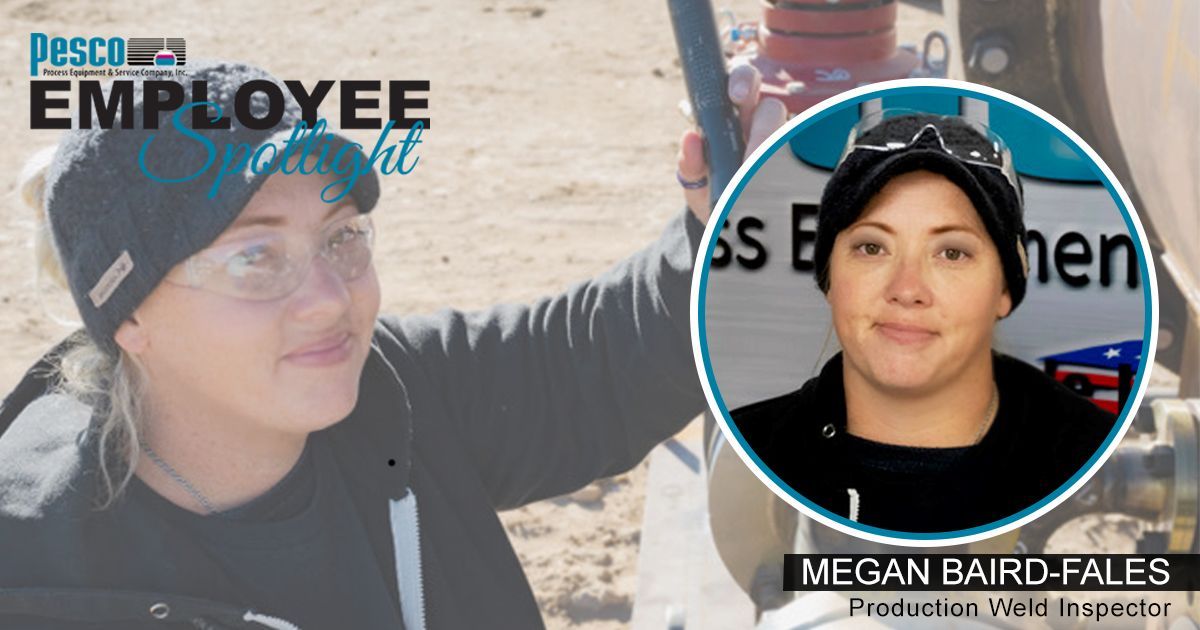
05 Jan, 2023
Megan Baird Production Weld Inspector Megan Baird has been a part of the PESCO team for 3 years. She contributes an element of spunk, creative interest, and exceptional attention to detail. After taking a few years to invest in the vital role of becoming a mom, Megan was ready to get back into the workforce. PESCO gave her the opportunity she needed. Megan was an experienced welder and weld inspector. To refresh her skills, she participated in PESCO’s first Welding Bootcamp at San Juan College. Upon successful completion of the bootcamp, Megan took a position as a welder’s helper at PESCO’s La Plata site. When the opportunity arose, she volunteered to head up the K123 house project hoping it would lead to other opportunities. Her strategy proved accurate, and in a short time, she moved on to building skids at PESCO South. When the COVID-19 shutdowns began, there were several cutbacks. Megan’s position was halted, and she was laid-off. Determined to continue working at PESCO, she applied for various positions as they became available. After a strong recommendation from Megan’s former supervisor at PESCO South, she was offered a new position. She came on as a parts welder. Megan moved around to a few other projects, including work on the BayoTech Prototype, before moving into her current position. In her role as a QC Inspector, she undertakes weld inspections for departments including Weld Assembly, Code Weld, and Parts Weld. In addition, Megan’s position requires that she verify that raw materials meet specifications before they are used in the welding process. She also tracks and updates welding qualifications. When asked what she appreciates about PESCO, she said she “I enjoy the friendly culture where people know your name and take an interest in you as a person. Everyone is approachable. No one here is too important to be engaging and I appreciate that I am greeted by name.” She is grateful for the independence she has gained since working for PESCO. After a difficult divorce, Megan was left to build from the ground up. Her dad helped her find a place to rent and her mom gave her a vehicle. Working at PESCO has enabled Megan to purchase her own home and vehicle, providing stability for her and her daughter. She says her daughter is thriving and is part of the gifted program at school. Megan is also an artist. Some of her art pieces are on display at PESCO South in the Engineering Office. Before coming to PESCO, Megan used her talent to produce ISO Location Drawings for various businesses in the oil and gas industry. When asked about the culture of PESCO, Megan expressed gratitude for the intentionality toward developing leaders. She said, “Just because you get a promotion, it isn’t taken for granted that you know everything. Books are recommended to help people become better leaders.” She went on to talk about the quality of life that a person experiences when they are happy at their job. PESCO’s employees are, for the most part, happy because they are treated with respect and are valued. This in turn impacts their family and community lives, enabling employees to build better futures.t
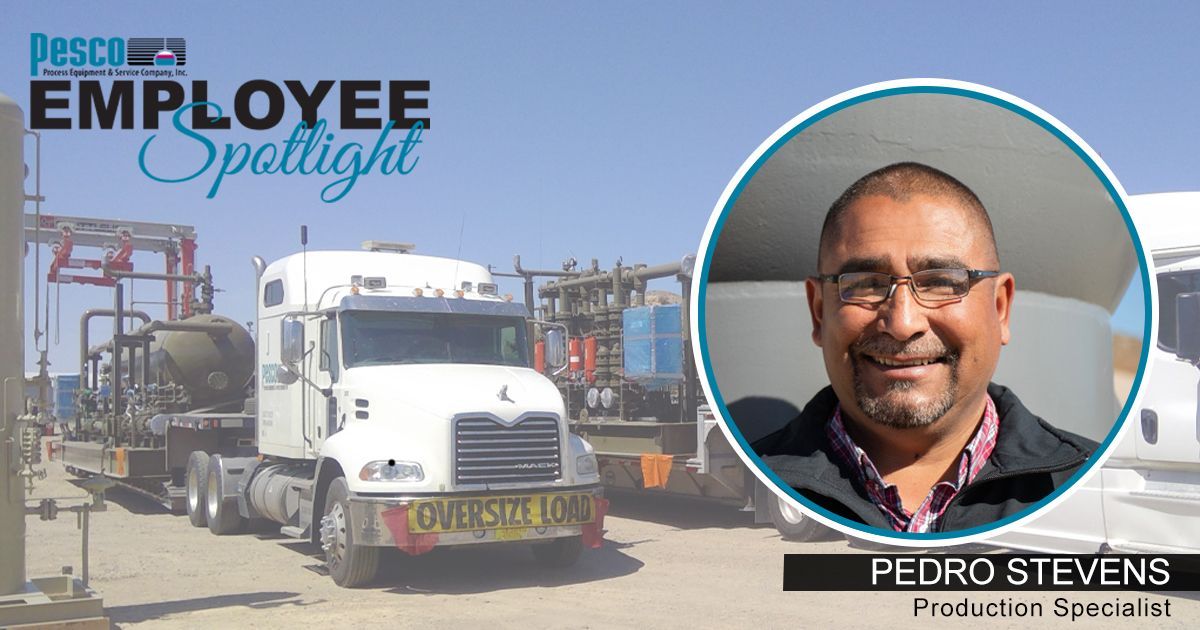
08 Nov, 2022
When asked to describe PESCO, without hesitation, Pedro Stevens responded, “Second chance.” Originally from Albuquerque, the move to Farmington was a decision he and his wife felt would be in the best interest of their family and future. Pedro spent several years incarcerated and would repeatedly succumb to the temptation of drug addiction. The change of pace and location was one of the best decisions he ever made. It was only four days after his release from prison that Pedro began his career at PESCO. “It’s working out pretty well.”, he said with a smile. Pedro has been with PESCO for four years. He started as a night shift pipefitter, he was promoted to paint and blast, earned certification as a paint and blast specialist, then moved to his current role as production specialist. Pedro says he enjoys the constant movement here at PESCO. There is always something changing, and it challenges him to adapt, to work with others and to reach the end goal. Pedro also appreciates being part of a team that consistently encourages him to grow. When discussing the topic of leadership, Pedro expressed his view that a good leader is one who can rally their team and inspire them to think outside the box, enabling the team to move toward a common goal. Once people are inspired to go beyond their self-imposed limitations, they discover a new sense of confidence and pride. He noted that a second key trait of a leader is one who will jump in right alongside their team when help is needed. It’s Pedro’s goal to be this type of leader no matter what he is challenged with at PESCO, or in life. Married 13 years, he and his wife Brittney have five kids: four boys and one girl. In his personal time, Pedro enjoys reading, church, fishing, watching his kids sports and his daughter’s cello performances. Pedro has a great sense of humor and enjoys making people smile. A couple of things few people know about him are his interest in world history and his love of Celtic music. One day he would like to travel to Ireland. He has overcome the odds and has worked hard to build stability and security for his family. In the next five years, he sees himself continuing his PESCO career and sustaining the lifestyle he now enjoys.
USEFUL LINKS
© 2024
All Rights Reserved | Process Equipment & Service Company (PESCO)



